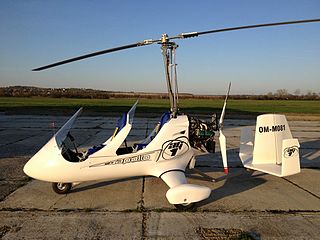Related Research Articles

The Aero-Works Aerolite 103 is an American single seat, high-wing, pusher configuration ultralight aircraft, designed by Terry Raber and introduced by Aero-Works, Inc, of Millersburg, Ohio, in 1997. The aircraft's model number indicates that it was designed to comply with the Federal Aviation Administration FAR 103 ultralight rules.

The ISON Airbike and Tandem Airbike are a family of American high-wing, tractor configuration ultralight aircraft, that were available in kit form. The single-seat Airbike was introduced in 1994 and the two-seat Tandem Airbike was unveiled in 1996.

The Avenger is a single-seat, Canadian low-wing, tractor configuration ultralight aircraft. The Avenger was introduced in 1994 and is available as a kit or as plans from Fisher Flying Products.
The InterPlane Griffon is a single seat, high wing, single engine, pusher configuration, tricycle gear ultralight aircraft, that was produced in kit form from InterPlane Aircraft of Zbraslavice, Czech Republic.
The Hy-Tek Hurricane 103 is a family of single-engined, high wing tricycle gear-equipped aircraft that were available in kit form from Hy-Tek Hurricane of Aurora, Oregon.
The Light Miniature Aircraft LM-1, LM-2 and LM-3 are a family of American high wing, conventional landing gear, strut-braced, single engine ultralight aircraft that are scale reproductions of famous general aviation aircraft. The designs were all available as plans from Light Miniature Aircraft of Okeechobee, Florida for amateur construction.
The Aircore Cadet is an American ultralight aircraft that was designed by Jim Scott and produced by Aircore Industries in the early 1980s. The aircraft was supplied as a kit for amateur construction.
The Howland H-3 Pegasus is an American ultralight aircraft that was designed by Bert Howland and made available by Howland Aero Design in the form of plans for amateur construction, with kits provided by Aircraft Spruce & Specialty Co. The H-3 first flew in 1988.
The LiteWing Aircraft LiteTrike, also called The Lite Trike, is an American ultralight trike that was designed and produced by LiteWing Aircraft of Caryville, Tennessee in the late 1990s. The aircraft was supplied fully assembled.
The Air Command Commander is an American autogyro that was designed and produced by Air Command International, with its first flight in 1984. Production was completed by 2003. The aircraft was supplied as a kit for amateur construction.
The Summit 103 Mini Breeze is an American powered parachute, designed and produced by Summit Aerosports of Yale, Michigan.
The Midwest Hornet is an American autogyro that was designed by Don Shoebridge and made available by Midwest Engineering & Design in the form of free plans for amateur construction.
The North American Rotorwerks Pitbull Ultralight is an American autogyro, designed and produced by North American Rotorwerks of Tukwila, Washington. When it was available the aircraft was supplied as a kit for amateur construction, but by 2013 production had been suspended.
The Aquilair Kid is a French ultralight trike designed and produced by Aquilair of Theizé. The aircraft is supplied as a kit for amateur construction or as a complete ready-to-fly-aircraft.
The Bagalini Bagalini is an Italian homebuilt ultralight aircraft that was designed by Marino Bagalini. The aircraft is supplied in the form of plans for amateur construction.
The Vortech Sparrow is an American autogyro that was produced by Vortech of Fallston, Maryland. When it was available the aircraft was supplied in the form of plans for amateur construction. Vortech also supplied rotor blades and some key parts for the design.
The Paraplane WD-1 Wind Dancer is an American powered parachute that was designed and produced by Paraplane International of Medford, New Jersey. Now out of production, when it was available the aircraft was supplied as a kit for amateur construction.
The Parascender I, originally just called the Parascender, is an American single-seat powered parachute that was designed and produced by Parascender Technologies of Kissimmee, Florida and introduced in 1989. Now out of production, when it was available the aircraft was supplied as a kit for amateur construction.
The Calumet Snobird Explorer is an American autogyro produced by Calumet Motorsports of Lansing, Illinois, introduced in May 1997. Now out of production, when it was available the aircraft was supplied as a kit for amateur construction.

The Apollo Gyro AG1 is a Hungarian autogyro produced by Apollo Ultralight Aircraft, of Eger and introduced in 2012. The aircraft is supplied ready-to-fly.
References
- ↑ "Gyroplanes". Aircraftdesigns.com. 2001-05-05. Archived from the original on 2012-03-26. Retrieved 2012-04-10.
- 1 2 3 4 Cliche, Andre: Ultralight Aircraft Shopper's Guide 8th Edition, page F-1. Cybair Limited Publishing, 2001. ISBN 0-9680628-1-4
- ↑ Downey, Julia: 2005 Trikes 'Chutes and Rotorcraft Directory, Kitplanes, Volume 22, Number 2, February 2005, page 54. Belvoir Publications. ISSN 0891-1851
- 1 2 Bertrand, Noel; Rene Coulon; et al: World Directory of Leisure Aviation 2003-04, page 203. Pagefast Ltd, Lancaster UK, 2003. ISSN 1368-485X
- ↑ Hollmann, Martin (14 July 1984). "Bumble Bee Performance and Stress Analysis" (PDF). aircraftdesigns.com. Archived from the original (PDF) on 7 July 2011. Retrieved 20 August 2020.